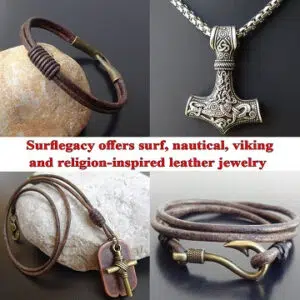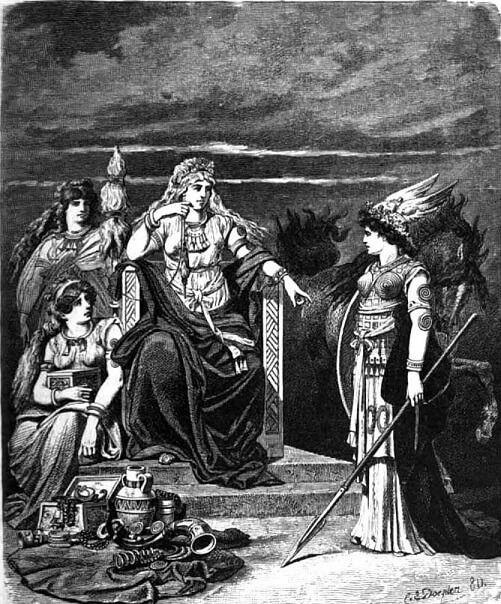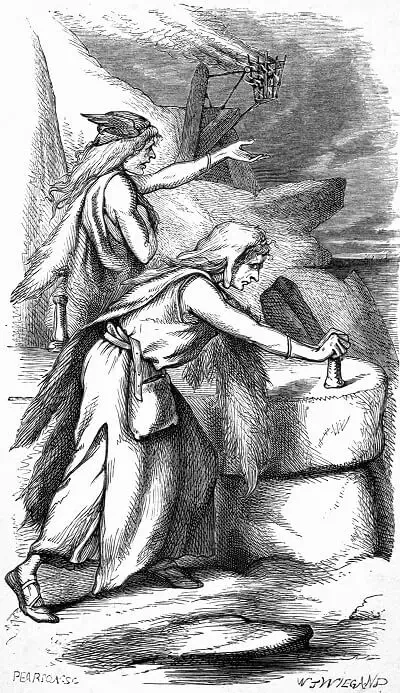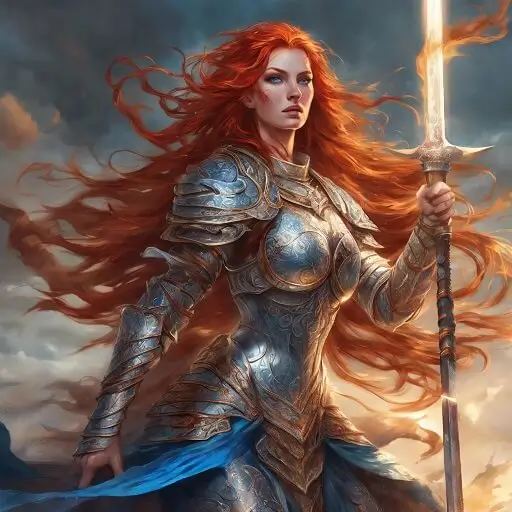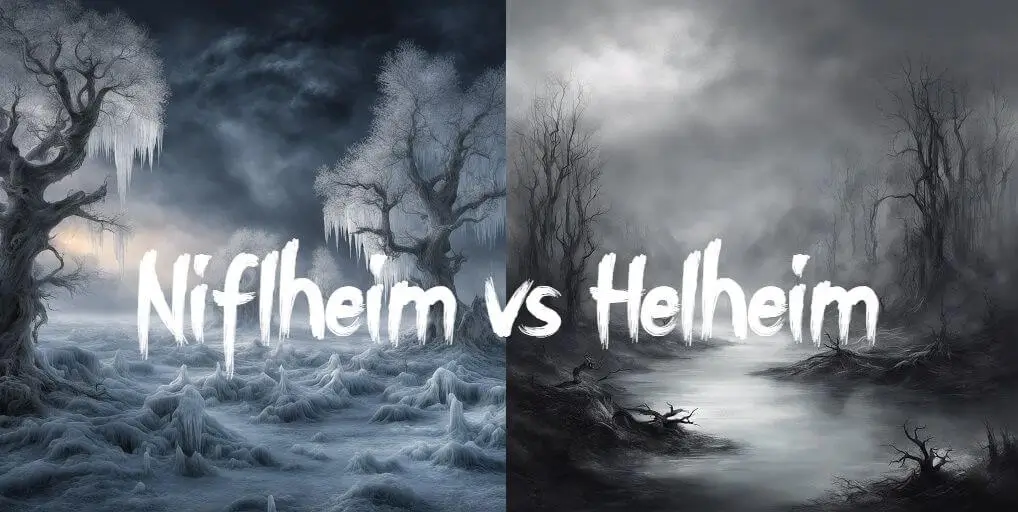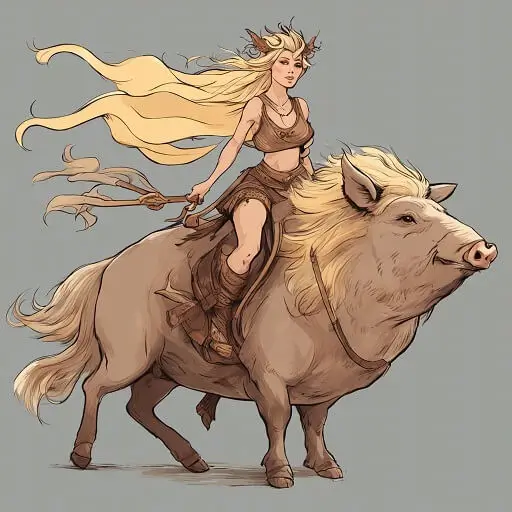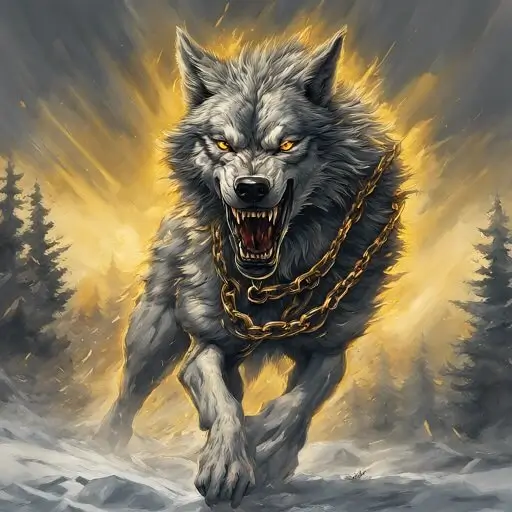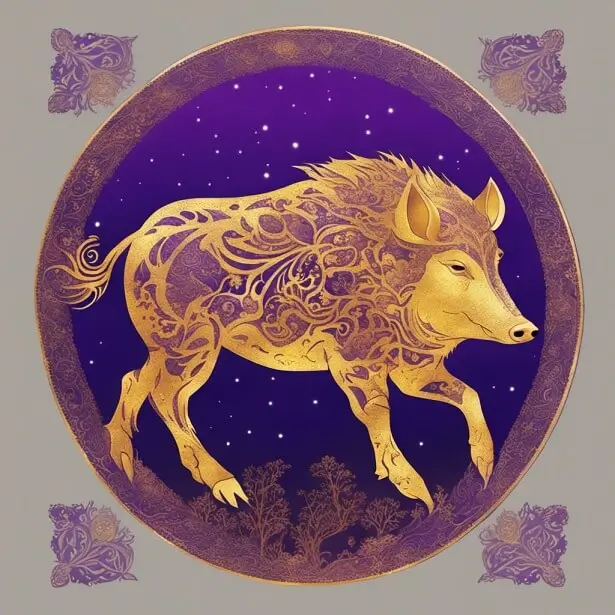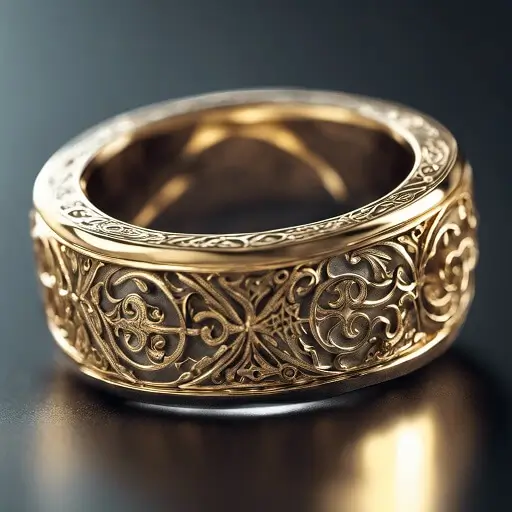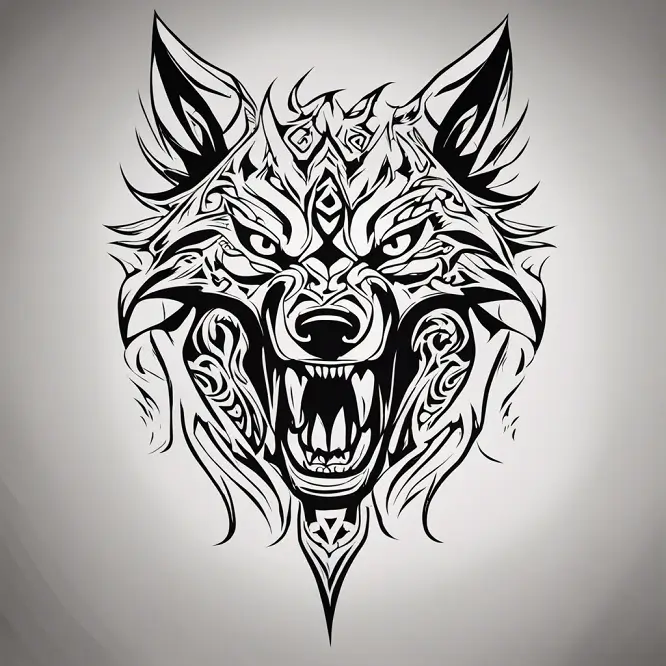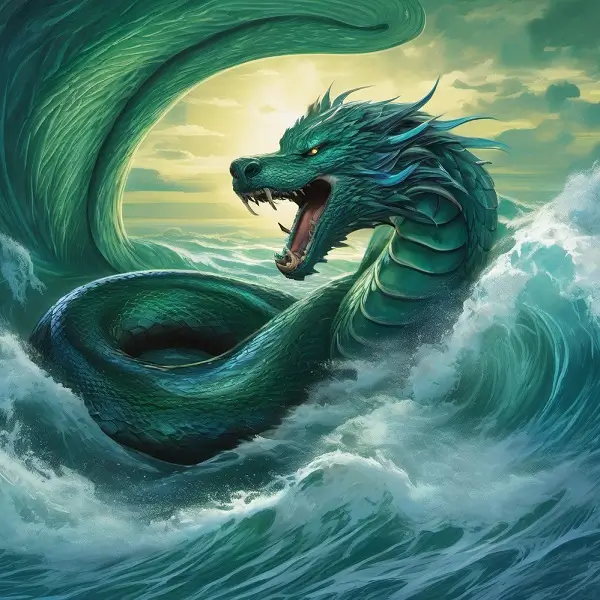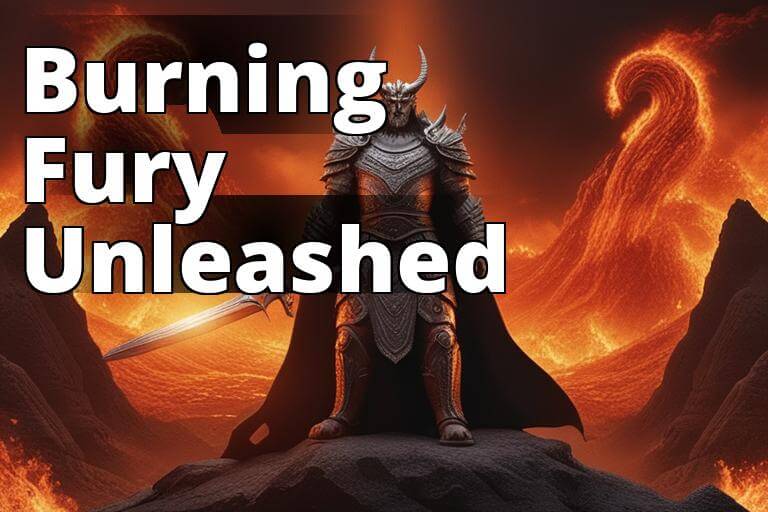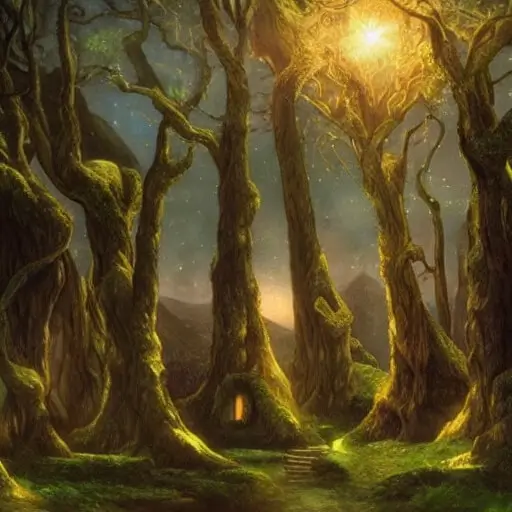In the grand and mesmerizing cosmos of Norse mythology, each god and goddess holds their own unique and pivotal role in the tapestry of tales. Among these divine figures, our focus today shifts towards an intriguing character, often overshadowed by the likes of Odin or Thor.
Her name is Gná – a messenger goddess who traverses the cosmos on her mythical steed, Hófvarpnir. Beyond her communication duties, she embodies travel, transitions, and the fascinating concept of the ‘in-between.’
Let’s embark on a journey together to unveil the mysteries that shroud this less-explored yet essential figure in Viking lore, navigating the ancient sagas and exploring her enduring relevance in the modern world. Your journey into the captivating world of Gná starts here.
Who is Gná? Delving into the Origins and Mythology
In the intricate tapestry of Norse mythology, a pantheon of powerful deities and fascinating beings come to life, each with their unique stories and roles. Among them, one figure transcends the boundaries of worlds, serving as an intermediary between divine entities. Her name is Gná, and her journey through the celestial realms is as intriguing as it is inspiring.
Gná is a goddess in Norse mythology, known for her role as the messenger of Frigg, the queen of the Æsir and the wife of Odin, the Allfather. Her existence is primarily attested in the Prose Edda, a 13th-century compilation of Norse myths written by the Icelandic scholar Snorri Sturluson. In this work, Gná is depicted as a divine courier, relaying messages and executing tasks for Frigg across the Nine Realms.
The very name ‘Gná’ hints at her role and characteristics. In Old Norse, Gná’s name is believed to mean ‘to tower’ or ‘to go into a trance,’ pointing towards her transcendent nature and her capacity to traverse different realms. Her trusty steed, Hófvarpnir, adds another dimension to her celestial travels, capable as he is of moving through air and water with ease.
Beyond her role as a messenger, Gná represents the concept of transition and change, often seen as the one who initiates progression of events. This reflects in her journeying between realms, often carrying messages that have far-reaching implications on both mortal and divine affairs.
However, despite her significance in the Norse divine hierarchy, much about Gná remains shrouded in mystery. The sparse references to her in the surviving sources tantalize us with the promise of a larger narrative waiting to be unraveled. The allure of her character lies in these gaps, these uncharted spaces that leave room for exploration and interpretation.
As we delve into the origins and mythology of Gná, we encounter a compelling figure who stands at the intersection of worlds, a symbol of the enduring relevance of Norse mythology in our understanding of ancient belief systems and the human condition. She serves as a reminder that messages, and those who bear them, have the power to shape worlds, alter destinies, and transcend the ordinary.
Hófvarpnir: The Mystical Steed of Gná
Our journey into the life of Gná would be incomplete without a thorough exploration of her relationship with a key figure from the sagas – her mythical steed, Hófvarpnir. Derived from Old Norse, Hófvarpnir translates to ‘Hoof-Thrower,’ a name that brilliantly captures the essence of his unique abilities.
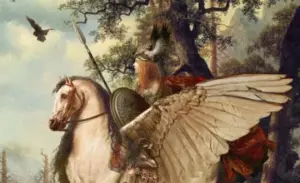
Gná with Hófvarpnir (image credit)
Hófvarpnir isn’t your ordinary steed. This extraordinary horse, born of legendary lineage – son of a giant horse and a mythical mare – possesses abilities far beyond our terrestrial understanding. With the power to traverse air and glide over the ocean, Hófvarpnir carries Gná across the Nine Realms, swiftly overcoming any barriers nature might impose.
The bond between Gná and Hófvarpnir is more than just functional; it is symbiotic. While Gná depends on Hófvarpnir for her celestial travels, the steed, in turn, finds purpose and direction under Gná’s guidance. Together, they embody a harmonious blend of independence and cooperation, encapsulating a profound aspect of Norse mythology – the beautiful balance of individuality and collective duty.
Moreover, the horse’s supernatural capabilities amplify Gná’s influence within the Viking lore. As the duo travel through air and water, they bring the heavens closer to the earthly realm, creating a tangible connection between humans and the divine.
Hófvarpnir’s narrative is interwoven with that of Gná, enhancing our understanding of the goddess’s role in the cosmic order. As we delve into the depths of their relationship, we unravel layers of symbolism that enrich our exploration of Viking mythology. So, hold on tight as we gallop further into the intricacies of these enthralling characters and their shared adventures across the cosmos.
Gná’s Role as Frigg’s Messenger
In the grand symphony of Norse mythology, each character plays a unique part, contributing to a narrative that is both timeless and intriguing. Amidst this divine ensemble, Gná holds a critical role as Frigg’s messenger, weaving a thread of communication between the realms of the cosmos.
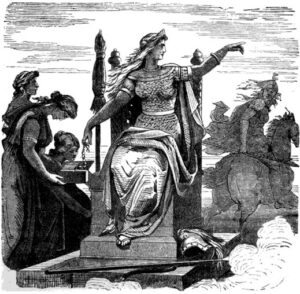
As the divine courier for Frigg, the queen of the Æsir and the wife of Odin, Gná stands as a vital link within the Norse pantheon. Her mission is not merely to relay messages but to ensure the effective functioning of divine commands, making her an essential player in the unfolding of cosmic events.
Frigg, being the foremost amongst the goddesses, has significant responsibilities, and her directives often hold profound implications. In this context, Gná’s role acquires even more importance. As the one who carries Frigg’s commands across realms, she essentially becomes the divine catalyst, setting events into motion.
Moreover, it’s not only the messages that she carries; Gná also represents Frigg’s influence and authority. Wherever she goes, she becomes an extension of the queen’s will, her presence a reminder of Frigg’s far-reaching power.
Perhaps one of the most enchanting aspects of Gná’s role is her ability to transcend the boundaries of the worlds. Mounted on her mythical steed Hófvarpnir, she can navigate air and water, journeying between realms to execute her missions. This ability symbolizes the fluidity of communication and the transcendence of boundaries, emphasizing the interconnectedness of the realms in Norse cosmology.
Yet, despite her significant role, Gná remains a figure of humility and dedication. She dutifully serves Frigg, carrying out her responsibilities without seeking the limelight. Her character embodies the virtue of service, reminding us that every role, no matter how seemingly small, has the power to shape the cosmos.
In exploring Gná’s role as Frigg’s messenger, we find an intriguing mix of duty, power, and humility. Her story highlights the importance of communication within the divine hierarchy, providing us with a unique lens to understand the complex interplay of relationships within the Norse pantheon. As we journey alongside Gná on her celestial errands, we come to appreciate the subtler nuances of her role and the depth of her character.
The Ásynjur Goddesses: Frigg’s Handmaidens and Their Roles
The Ásynjur, as articulated by Gangleri, represent the pantheon of Norse goddesses, each distinct in her divine role. At the helm of these is Frigg, the revered matriarch who resides in the splendid estate of Fensalir. Following her is Sága, dwelling at the grand abode of Søkkvabekkr.
The healing goddess Eir, celebrated as the supreme physician, holds the third rank. Gefjun, the guardian of virginity, receives maidens upon their death, standing fourth among the Ásynjur. Fulla, another virgin deity with golden accessories and loose tresses, bears the responsibility of managing Frigg’s footgear and safeguarding her secret counsel.
The sixth place is held by the exquisitely born Freyja, wife of Ódr and mother to Hnoss, so beautiful that the word ‘hnossir’ came to denote anything precious or attractive. Known by various names, Freyja is famous for her necklace Brísinga-men and her title, Lady of the Vanir.
The goddess of love, Sjöfn, diligently stirs the hearts of men and women, and Lofn, the eighth goddess, is celebrated for her kindness and her ability to secure permissions for marriages previously denied or forbidden.
Vár, the ninth Ásynjur, is the overseer of oaths and vows between men and women, seeking retribution upon those who commit perjury. The wise Vör, with her inquisitive spirit, lets nothing be hidden from her.
Syn, the doorkeeper of the hall, stands as the defender in trials, rejecting suits she deems unjust. Hlín, Frigg’s protector, shields men from danger. The thirteenth, Snotra, personifies prudence and gentility, offering her name as a byword for moderation.
And finally, we meet Gná, the celestial courier. Entrusted by Frigg to journey through various lands on her errands, she is famed for her steed Hófvarpnir, capable of traversing sky and sea.
Gná’s Attestations in The Prose Edda
When it comes to Gná’s attestations, they are indeed fleeting, appearing most notably in Snorri Sturluson’s Prose Edda. This iconic work provides us a rare glimpse into the role and significance of Gná within the Norse divine assembly. Particularly, it’s the 35th chapter of the Gylfaginning that sheds light on her identity and duties.
In this chapter, Sturluson systematically recounts the goddesses or Ásynjur of the Norse pantheon, with Frigg leading the order.
A pivotal event in Gná’s divine narrative is her intriguing encounter with the Vanir, a group of gods in the Norse pantheon. This event underscores the wonder and curiosity her unique role and abilities elicited from her divine counterparts.
During one of her errands, Gná was witnessed in flight by some of the Vanir. They were so astounded by her aerial traversal that they questioned what they were seeing:
“What flieth there? | What fareth there, Or glideth in the air?”
Gná’s response clarified her unique mode of travel. She stated that she wasn’t flying, per se, but moving swiftly across the sky and sea on her special horse, Hoof-Tosser (Hófvarpnir). This horse was a prodigious creature, fathered by Hamskerpir and mothered by Gardrofa. Her movement, so quick and effortless, gave the impression of flight:
“I fly not, | though I fare And in the air glide On Hoof-Tosser, | him that Hamskerpir Gat with Gardrofa.”
This exchange gives further depth to the influence and significance of Gná within Norse mythology. Her name, Gná, led to the formation of the term ‘gnæfa.’ This term essentially translates to ‘soaring high’ or ‘towering,’ symbolizing her remarkable capability of traveling across the sky and sea.
Lastly, it is important to note that Sól and Bil, two other key figures among the Ásynjur, were also a part of this narrative. Their specific roles and stories, however, have been detailed elsewhere and are beyond the scope of our focus on Gná.
Comparative Mythology: Gná and Other Messenger Deities
As we journey through the annals of global mythology, one quickly realizes that the figure of the messenger deity is not unique to Norse lore. Different cultures worldwide have revered their own divine intermediaries, often bearing striking resemblances to our Norse heroine, Gná. It is in these parallel narratives that we truly begin to appreciate the universality of certain mythological archetypes.
In Greek mythology, for instance, Hermes stands as a remarkable counterpart to Gná. Just as Gná served as Frigg’s messenger, Hermes undertook similar responsibilities for the Olympian gods. Both deities are swift and shrewd, traversing multiple realms and embodying the spirit of transition.
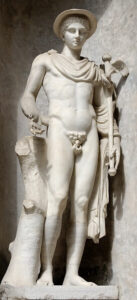
Hermes Ingenui (Vatican Museums)
Yet, there are also striking contrasts. Unlike Gná, who rides her mythical steed, Hermes possesses winged sandals. Additionally, where Gná is a goddess under a queen, Hermes stands as a male deity in a patriarchal pantheon, highlighting how different cultures interpret the messenger role.
Another intriguing parallel can be drawn with the Hindu deity, Narada. Just as Gná plays a crucial part in the cosmic conversation, Narada, a divine sage in Hindu mythology, carries messages between gods and humans. Both are omnipresent figures, found wherever a narrative transition is needed. However, while Gná’s focus remains on fulfilling Frigg’s will, Narada often takes a more proactive role, influencing events to maintain cosmic harmony.
By examining Gná alongside other global messenger deities, we gain a deeper understanding of her place within the universal tapestry of mythology. We observe a fascinating blend of shared archetypes and unique cultural interpretations. This exploration underscores not just the breadth of Gná’s role in Norse mythology, but also the depth of her resonance within our collective human imagination. As we journey onwards, we continue to discover more about this captivating goddess, her mythical steed, and the profound wisdom encapsulated in their tales.
The Influence of Gná in Modern Popular Culture
In the modern era, the enchanting tales of Norse mythology have broken the bounds of ancient texts and academic studies, finding new life in various facets of popular culture. From blockbuster films to bestselling novels, the echoes of Asgard and its divine inhabitants reverberate, igniting our collective imagination. Amid these modern interpretations, we find intriguing portrayals of our celestial courier, Gná, showcasing her enduring relevance.
One of the areas where Gná’s influence is most prominent is in the realm of literature. Her character has been reimagined and adapted in numerous fantasy novels, offering readers a fresh glimpse into her role as a messenger goddess. For instance, in some works, Gná is portrayed not merely as a messenger but as a harbinger of change, symbolizing pivotal turning points in the narrative.
Gná’s influence extends to the world of gaming as well, where Norse mythology is a popular theme. Here, the concept of a divine messenger traversing realms becomes a dynamic and interactive experience for players. For example, in some games, players can summon Gná as an ally in their adventures, bringing her powers of travel and transition to life in a digital realm.
Perhaps the most visually striking renditions of Gná are found in graphic novels and comics, where her celestial travels are beautifully illustrated. In these narratives, Gná’s character often inspires themes of bravery, exploration, and adaptation, resonating with readers in a deep and personal way.
The portrayal of Gná in modern popular culture underscores the timelessness of Norse mythology. Her story continues to captivate, not just as a figure from a bygone era, but as a symbol of change and transition that speaks to us even today. Whether we find her on the pages of a book, the screens of our gaming consoles, or the frames of a comic strip, Gná continues to journey with us, reminding us of the beauty of transition and the thrill of the unknown. As we continue exploring her influences, we realize that her journey, like ours, is never-ending.
Faqs
Are there specific rituals or festivals associated with Gná in Viking culture?
Unlike some other Norse deities, there isn’t much historical evidence for specific rituals or festivals dedicated to Gná. It’s possible that she was revered as part of the broader pantheon, with her role as a messenger goddess being recognized within the overall practice of Norse religion.
Is Gná a warrior goddess like Valkyries in Norse mythology?
No, Gná isn’t a warrior goddess. Unlike the Valkyries, who escort the fallen warriors to Valhalla, Gná’s role is primarily as a messenger and a figure of transition. However, her ability to navigate between realms and influence events could be seen as a different form of ‘battle.’
What role does Gná play in Ragnarok, the apocalypse in Norse mythology?
While many gods play crucial roles in Ragnarok, there isn’t a specific reference to Gná’s role in this cataclysmic event in the extant sources. However, as a goddess of transitions, one might interpret that she would serve as a bridge between the destruction of the old world and the emergence of the new.
Is there a connection between Gná and the Northern Lights?
The Northern Lights have been interpreted differently across various Nordic cultures. While some have associated them with the Valkyries or the Bifrost bridge, there isn’t a known connection between Gná and this celestial phenomenon. That being said, the imagery of a celestial path through the skies could indeed be reminiscent of Gná’s celestial travels.
Shop Viking Jewelry
Are passionate about Norse Mythology? Finding the ideal piece of Norse Jewelry can be challenging and time-consuming, especially if you lack inspiration or don’t know where to look.
Surflegacy, has you covered. We have a wide range of Viking Jewelry in various styles, shapes, colors, and materials, to accentuate your Viking spirit and look.
